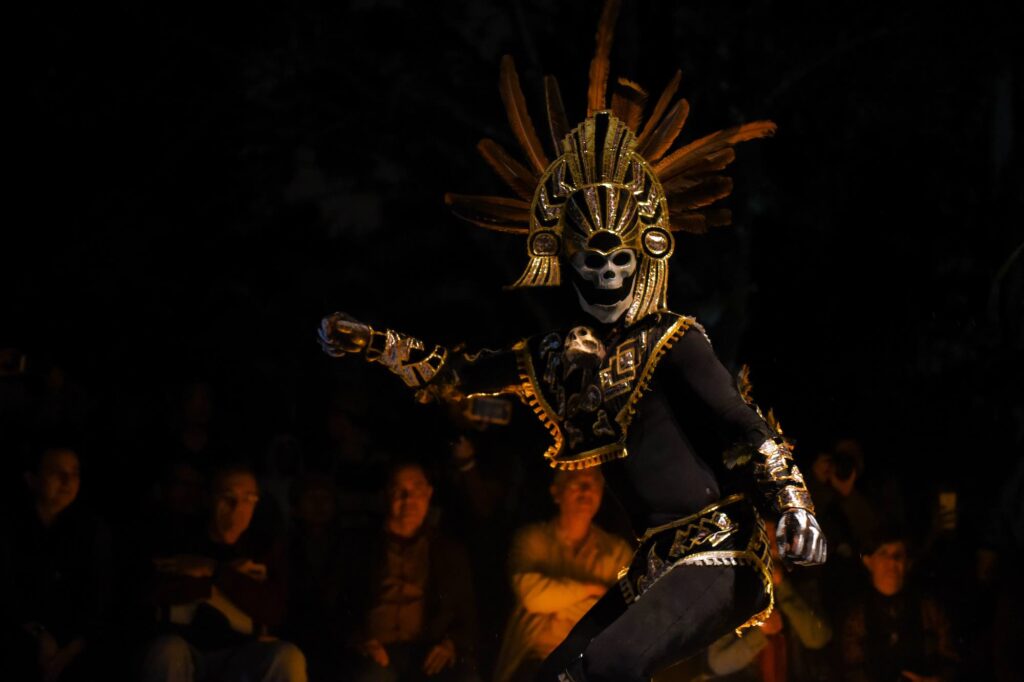
Rober Diaz. Peninsula 360 Press [P360P].
It is known for certain that there are four places that occupied the cosmogony of the ancient Aztecs: The House of the Sun in Teotihuacan; the House of the Warrior Women and the Corn God: CincalcoThe Tlalocán or Paradise of the God of Water, and the Mictlán or "place where the dead dwell."
These points correspond to the four cardinal points but, unlike the western vision, there is a centre on its three cosmic planes called Omeyocan where the creative couple resides: OmeteóltIn the centre of this central plane is the Huehuetéolt and, at the bottom of these plans, the lord of the underworld: Mictlantecuhtli and his kingdom which is the Mictlán or place of the dead.
This place is a spacious, windowless place from which one cannot leave or return, it is the place of the damaged, the house of darkness: the Yoa ichan or house of the night, the Yoalli ichán region of mystery, the Ximoayánwhere the flesh is.
To enter this site, one had to go through various sorrows which were generally located towards the north; however, it is believed that they thought there were also four entrances - in relation to the four cardinal points and there was also a fifth one located in the centre: Tlaxiccobut it was also common to hear that this main entrance into the darkness was at the western point in the cave of Cincalcoo Cicalco which, as we mentioned before, was the entrance of the warrior women, the same direction where you see them disappearing every afternoon into the sun and where they live Tótec Chicahua and Hueman.
The way to get there was mysterious and full of sorrows, but those who died were prepared, according to Friar Bernardino de Sahagún their heads were wet and they were buried with a pitcher of water because they should pass through:
- First, by two saws that are meeting each other.
- Then, by a place where a snake is waiting for them.
- Later, where the green lizard called Xochitónal.
- Then, across eight moors.
- Next, through eight hills.
- Then, where the cold wind cuts like razors.
- Later, by the River Chiconahuapán and cross it on the back of a dog Xoloescuincle.
- Before finishing, by the place where the offerings due to Mictlantecuhtli.
- And after four years, the nine hells: Chicunaumictlán.
The gods that inhabit the infernos are like most Aztec gods, a duality made up of a male and a female god: Mictlantecuhtli and Mictecacíhuatl. The chroniclers know that his scepter is made of precious objects such as bones, skulls and ribs and that he used them Quetzalcóatl when he went down to the Mictlán to forge the dust from which it would form human beings.
As messengers they had the Yaotequihua -messenger of the God and Goddess of Hell-, which are the owls and the technoloths which if they appeared in the bed or around the sick and that was an unmistakable sign that they would die.
The Mictecas were the agents of the underworld, who were charged with preventing anyone who set foot in that kingdom from leaving. In addition, there were inferior beings dedicated to inhabit the suburbs of the underworld who had various functions that are mentioned and presented themselves as couples in their domains: the Ixputequewho has a broken foot; Nexoxochitlthe one who throws flowers; Nextepehua who blinds with ashes; Micapletacalli which is the dead man's box; Tzontémoc which is the one who falls on his head; Chalmecacíhuatlor the sacrificial and Acolnahuácatl the one in the crooked region.
To Mictlán All those who died of disease, whether they were princes, lords or macehuals, those who did not die in the war, nor those who died through sacrifice to the gods, much less those warrior women who died in childbirth - considered almost goddesses; nor did those who died by drowning or some event related to water or burned by lightning, like the lepers. Those who had died by fire were not to go there.
They thought that the paths taken by the souls of the dead did not depend on their behavior in life, but on the kind of death they had gone through. The Mictlan, more than being a punishment for sin, was a way of purification with which the souls found eternal rest, and one where there was no room for social differences as on Earth.

